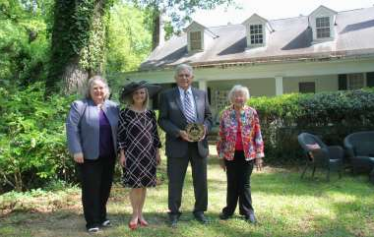On a beautiful, Spring afternoon in Millbrook, Alabama, members of the National Society of the Sons and
Daughters of Antebellum Planters and guests gathered at Ellerslie, the home of Bolling Hall: Revolutionary War
soldier at age 16, a friend of Lafayette whom he befriended at Yorktown, a three-term US Congressman from
Georgia, and an early settler in Alabama before it was a state.
While a congressman, Bolling started buying land in the Alabama Territory and the family
eventually accumulated 200,000 acres. Upon embarking on his emigration to the Alabama
Territory, he brought with him a sawmill, building materials as well as a Philadelphia
carpenter who was instrumental in building a sturdy home. The original tongue-and-
groove floors still are there. Unlike other log cabins or early homes, it had four elegant
matching mantles and large brass locks imported from England and Philadelphia on
each door, interior, and exterior.

Deborah Hicks, Leslie Kirk, J.J. Smith, Ann Cheney
Ellerslie is the first home in central Alabama to have glass windows and considered today to be the oldest frame
house in Alabama. Treasurer General, J.J. Smith, a great-great-great-great- grandson of Bolling Hall presented
our society’s marker for the house to his kinswoman, Jeanne Hall Ashley, a great-great-great-granddaughter of
Bolling’s who now lives at Ellerslie.
In colonial America the first floors were wide, thick planks cut from the continent’s abundant old-growth forests.
Because of the trees’ age and massive diameter, the desirable heartwood was extremely tight-grained, making
the lumber harder and more durable than the relatively immature wood of the same species that is harvested
today.
Converting the timber into usable lumber was an arduous process. The predominant method available to create
dimensional boards was to pit-saw the logs into planks. This required two men: One stood in a pit beneath a
huge log that had been squared with hand tools, while the other perched atop it. Working together, they pushed
and pulled at opposite ends of a long-bladed saw, carefully following chalk lines that indicated the direction of
the cut. These rough-sawn planks were finished with plain, squared edges; laid side by side, and face-nailed into
the floor joists.
Tongue-and-groove molding is a precise method of joining boards together along their lengths by fitting a
protruding “tongue” on one board into a channel cut on the adjoining board. With tongue-and-groove
installation, the nails are driven through the tongue, forcing the boards together; this also conceals the nail holes,
creating an unmarred surface. One can imagine the precision and skill need to create tongue-and-groove floors in
the days before steam power was available.
Bolling was a contemporary of James Madison, James Monroe, Henry Clay, John C. Calhoun, and William
Lowndes Yancy. He purchased a carriage from James Madison and took it to Alabama. The metal wheels from
the carriage were made into fireplace andirons. He was instrumental in making sure Montgomery was the capital
of this fast-growing state. Early letters to Bolling from Washington were addressed simply to “Bolling Hall,
Alabama Territory.”
He represented the Milledgeville district while in Congress, and in the domestic arrangement was the member of
a mess composed of John C. Calhoun of South Carolina, Golson, and Pleasants of Virginia, Dr. Goudict of New
Jersey, Justen and Barnett of North Carolina, and himself.
His friends in Congress couldn’t believe he was moving to this wild territory, but he extolled the virtues of the
rich Alabama soil and opportunities in contrast to Virginia where the vitality of the land had diminished and
much of Georgia was filled with red clay.
In 1823, Bolling became one of the first trustees of the University of Alabama before it was built. Much of early
life in pioneering this new land is chronicled in the thousands of letters and papers donated by the Hall family to
the Alabama Department of Archives and History, its largest family collection.
A cemetery is located on the property filled with tombstones of Hall family members, each one with a story.
Jeanne was able to recount some of the fascinating histories of this early Alabama family. Ellerslie is also on the
National Parks Service’s National Register of Historic Places.